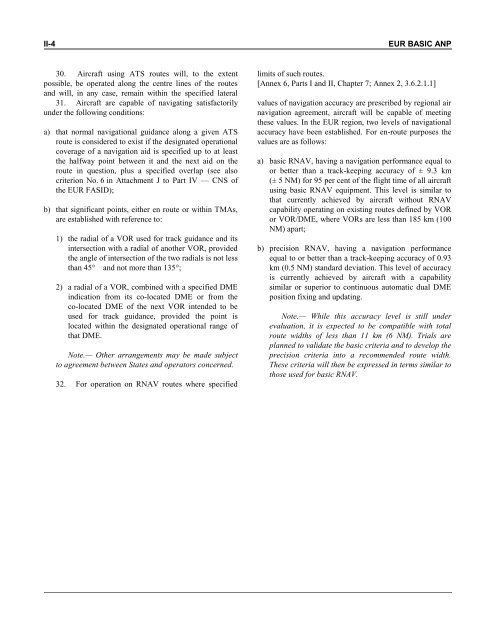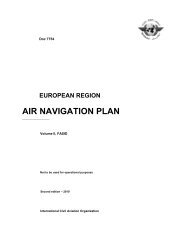7754 Vol 1 Flyleaf - ICAO Public Maps
7754 Vol 1 Flyleaf - ICAO Public Maps
7754 Vol 1 Flyleaf - ICAO Public Maps
You also want an ePaper? Increase the reach of your titles
YUMPU automatically turns print PDFs into web optimized ePapers that Google loves.
II-4 EUR BASIC ANP<br />
30. Aircraft using ATS routes will, to the extent<br />
possible, be operated along the centre lines of the routes<br />
and will, in any case, remain within the specified lateral<br />
31. Aircraft are capable of navigating satisfactorily<br />
under the following conditions:<br />
a) that normal navigational guidance along a given ATS<br />
route is considered to exist if the designated operational<br />
coverage of a navigation aid is specified up to at least<br />
the halfway point between it and the next aid on the<br />
route in question, plus a specified overlap (see also<br />
criterion No. 6 in Attachment J to Part IV — CNS of<br />
the EUR FASID);<br />
b) that significant points, either en route or within TMAs,<br />
are established with reference to:<br />
1) the radial of a VOR used for track guidance and its<br />
intersection with a radial of another VOR, provided<br />
the angle of intersection of the two radials is not less<br />
than 45� and not more than 135�;<br />
2) a radial of a VOR, combined with a specified DME<br />
indication from its co-located DME or from the<br />
co-located DME of the next VOR intended to be<br />
used for track guidance, provided the point is<br />
located within the designated operational range of<br />
that DME.<br />
Note.— Other arrangements may be made subject<br />
to agreement between States and operators concerned.<br />
32. For operation on RNAV routes where specified<br />
limits of such routes.<br />
[Annex 6, Parts I and II, Chapter 7; Annex 2, 3.6.2.1.1]<br />
values of navigation accuracy are prescribed by regional air<br />
navigation agreement, aircraft will be capable of meeting<br />
these values. In the EUR region, two levels of navigational<br />
accuracy have been established. For en-route purposes the<br />
values are as follows:<br />
a) basic RNAV, having a navigation performance equal to<br />
or better than a track-keeping accuracy of ± 9.3 km<br />
(± 5 NM) for 95 per cent of the flight time of all aircraft<br />
using basic RNAV equipment. This level is similar to<br />
that currently achieved by aircraft without RNAV<br />
capability operating on existing routes defined by VOR<br />
or VOR/DME, where VORs are less than 185 km (100<br />
NM) apart;<br />
b) precision RNAV, having a navigation performance<br />
equal to or better than a track-keeping accuracy of 0.93<br />
km (0.5 NM) standard deviation. This level of accuracy<br />
is currently achieved by aircraft with a capability<br />
similar or superior to continuous automatic dual DME<br />
position fixing and updating.<br />
Note.— While this accuracy level is still under<br />
evaluation, it is expected to be compatible with total<br />
route widths of less than 11 km (6 NM). Trials are<br />
planned to validate the basic criteria and to develop the<br />
precision criteria into a recommended route width.<br />
These criteria will then be expressed in terms similar to<br />
those used for basic RNAV.














